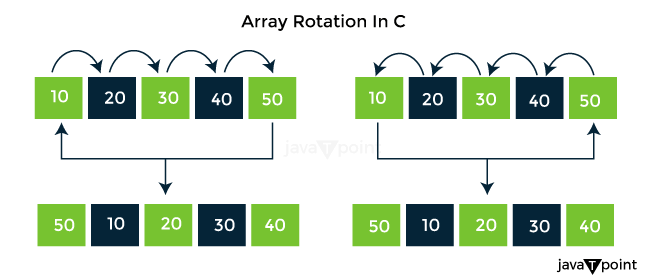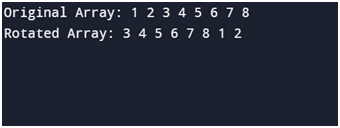Array Rotation in CArrays are useful in computer programming because they provide the foundation for data structures. Arrays are being one of the most frequent data types that enable the efficient storage and manipulation of large amounts of connected data. C is well-known for its low-level capabilities and efficiency, as well as its excellent array implementation. In this article, we'll dive deep into arrays in C, looking at their features, syntax, manipulation techniques, and the crucial role they play in building complex data structures. Arrays are constant collections of items of the same data type. They let you to save and retrieve several values with a single identity. Arrays in C have a fixed size and can hold elements of several primitive data types, including integers, characters, and floating-point numbers. They provide an efficient method of organizing and modifying data. Array elements are retained in memory in a continuous fashion, allowing for quick indexing and direct access to individual objects. Arrays are a useful way to store several values without having to use individual variables. Arrays let you to operate large datasets with a single identifier, which simplifies operations like locating, sorting, and updating objects. In C, arrays are declared by enclosing the data type of the elements in square brackets, followed by the array name and size. For example, C declares an array called "numbers" that may store 5 integer items. Array items are accessible by indices, which begin with 0 for the first element. By hiding the initial values behind curly braces, arrays can be initialised at the time of declaration. For example, int numbers[5] = {10, 20, 30, 40, 50}; initializes the "numbers" array with the given values. Individual items are accessed and modified using array indexes. The array name followed by the index in square brackets, such as numbers[2]; accesses the third member of the "numbers" array. Array traversal is the systematic examining and accessing of each element of an array. This technique is typically done out with the use of loops, such as the "for" or "while" loops. Array traversal is useful for doing computations, searching for certain values, or printing the elements of an array. Array searching is the process of searching for a certain value within an array. The two most frequent search algorithms are linear search and binary search. Linear search entails iterating across the array until the desired value is discovered. Although binary search is faster, it needs a sorted array. Divide the array in half and compare the target value to the middle item to narrow the search space. Sorting arrays arrange components in ascending or descending order, making data exploration, manipulation, and organisation simpler. C includes several sorting algorithms, each with its own set of benefits and temporal complexity. Array element change includes assigning new values, changing elements directly or via variables, and adding or removing array items. 
In C programming, arrays may be utilized in a variety of ways. They are widely used in mathematical operations to represent matrices, store and manipulate strings, allocate memory dynamically, and serve as the basic data structure for stacks, queues, and other data structures. When working with arrays, efficiency must be considered. The time complexity of array operations varies depending on the approach used. The efficiency of processes is governed by time complexity, and programmers should select the appropriate algorithm based on the requirements. Array space complexity should also be considered, especially when working with large datasets or allocating memory dynamically. Array Rotation:Array rotation is a way of moving array members by a defined number of positions. You can reorganize the array elements without changing their values using this procedure. Array rotation may be done in a variety of ways, depending on how the components are shifted to the left or right. There are two types: 1. Left rotation: The array's entries are rotated to the left by a predefined number of positions. Items moved from the array's left side are repositioned on the array's right side. This technique rotates the components in a circular motion. Consider the example: The elements 1 and 2 have been relocated to the right side of the array while the remaining components have retained their order. 2. Right rotation: The array's items are shifted to the right by a certain amount during right rotation. The items that were transferred to the right side of the array are subsequently filled on its left side. This procedure rotates the components in a circular motion as well, but in the opposite direction as rotation to the left.Consider the example: While the arrangement of the other components has not changed, elements 6 and 7 have been moved to the left side of the array. Example:Let us understand the above concept in C program: Output: 
Next TopicRandom Access File in C
|
 For Videos Join Our Youtube Channel: Join Now
For Videos Join Our Youtube Channel: Join Now
Feedback
- Send your Feedback to [email protected]
Help Others, Please Share










